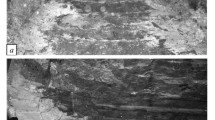Abstract
Premature shutdown of electrolytic baths after a short service life leads to an increase in the cost of aluminum and serious economic losses. The most important element governing the service life of an electrolytic bath is the hearth that is lined with refractory hearth blocks. Presence of one concealed crack, that is exposed in the start-up period, may lead to failure of the whole electrolyzer in the first year of service. There are many producers and users of hearth blocks, and there are many specifications for cathode hearth blocks, although the requirements for them are selected in a very empirical way without considering actual service conditions. Scientifically based requirements for the material of hearth blocks is still in the formation stage. In 2004 in four aluminum enterprises under major repair hearth blocks were used from nine different producers that made it possible during evaluation of the statistics for shutting down young baths to determine the effect of the structure and properties of hearth blocks on the service life of electrolyzers and to formulate requirements for hearth block material. The contribution of permeable porous cathode carbon blocks on premature shutdown of electrolyzers by a mechanism of hearth uplift due to formation of a lens of electrolyte and refractory reaction products is demonstrated. Critical gas permeability and the maximum size of permeable pores in refractory hearth units are determined. Applicability of the first and second Hasselman criteria for the heat resistance of hearth block materials is demonstrated for predicting shutdown of young baths by a crack development mechanism in blocks due to thermomechanical stresses.
Similar content being viewed by others
References
TU 1913-109-021-2003, Hearth blocks for aluminum electrolyzers.
DIN 5190-1997. Testing of Carbon Materials — Determination of Compressive Strength.
ISO-WD 15379-2. Carbonaceous Materials for the Production of Aluminum — Cathode Block Materials. Part. 2. Determination of Expansion due to Sodium Penetration Without Application of Pressure.
M. Sorley and H. Oye, Cathodes in Aluminum Electrolysis [Russian translation, P. V. Polyakov], Krasnoyarsk (1977).
S. A. Khramenko, P. V. Polyakov, A. V. Rozin, et al., “Effect of the structure of porosity on impregnation and the operating properties of hearth materials,” Light Metals, 795–799 (2005).
A. L. Yurkov, “Problems in the materials science of carbon hearth blocks for aluminum electrolyzers,” 4th Internat. Conf. “Carbon: fundamental problems of science, materials science, technology,”, 26–28 October, 2005. MGU in Lomonosova, Moscow (2005).
A. L. Yurkov, “Problems in the materials science of carbon hearth blocks for aluminum electrolyzers,” Ross. Khim. Zh., No. 21, 35–43 (2006).
D. P. H. Hasselman, “United theory of thermal shock,” J. Amer. Ceram. Soc., 52, No. 11, 600–604 (1969).
D. P. H. Hasselman, “Thermal stress resistance parameters for brittle refractory ceramics,” Amer. Ceram. Soc. Bull., 49, 1033–1037 (1970).
Author information
Authors and Affiliations
Additional information
__________
Translated from Novye Ogneupory, No. 4, pp. 3–12, April 2008.
Rights and permissions
About this article
Cite this article
Yurkov, A.A., Khramenko, S.A. & Borisov, V.I. Effect of the structure and properties of hearth carbon blocks on premature shutdown of electrolytic baths. Refract Ind Ceram 49, 90–98 (2008). https://doi.org/10.1007/s11148-008-9033-3
Received:
Published:
Issue Date:
DOI: https://doi.org/10.1007/s11148-008-9033-3




